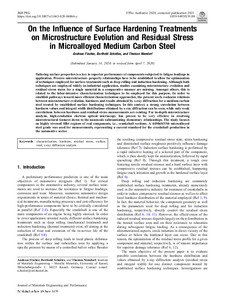| dc.date.accessioned | 2021-12-06T14:46:03Z | |
| dc.date.available | 2021-12-06T14:46:03Z | |
| dc.date.issued | 2020-06-09 | |
| dc.identifier | doi:10.17170/kobra-202111055032 | |
| dc.identifier.uri | http://hdl.handle.net/123456789/13424 | |
| dc.description.sponsorship | Gefördert im Rahmen des Projekts DEAL | ger |
| dc.language.iso | eng | eng |
| dc.rights | Namensnennung 4.0 International | * |
| dc.rights.uri | http://creativecommons.org/licenses/by/4.0/ | * |
| dc.subject | characterization | eng |
| dc.subject | hardness | eng |
| dc.subject | residual stress | eng |
| dc.subject | surface | eng |
| dc.subject | steel | eng |
| dc.subject | x-ray diffraction | eng |
| dc.subject.ddc | 620 | |
| dc.title | On the Influence of Surface Hardening Treatments on Microstructure Evolution and Residual Stress in Microalloyed Medium Carbon Steel | eng |
| dc.type | Aufsatz | |
| dcterms.abstract | Tailoring surface properties is a key to superior performance of components subjected to fatigue loadings in application. Process–microstructure–property relationships have to be established to allow for optimization of techniques employed for surface treatments such as deep rolling and induction hardening. Although both techniques are employed widely in industrial application, studies examining microstructure evolution and residual stress states for a single material in a comparative manner are missing. Amongst others, this is related to the labor-intensive characterization techniques to be employed for this purpose. In order to establish pathways toward more efficient characterization approaches, the present work evaluates relations between microstructure evolution, hardness and results obtained by x-ray diffraction for a medium carbon steel treated by established surface hardening techniques. In this context, a strong correlation between hardness values and integral width distributions obtained by x-ray diffraction can be seen, while only weak correlations between hardness and residual stress measurements are existing. For in-depth microstructure analysis, high-resolution electron optical microscopy has proven to be very effective in resolving microstructural features down to the nanoscale substantiating elementary relationships. The study focuses on highly stressed fillet regions of real components, i.e., crankshaft sections. A 44MnSiVS6 microalloyed steel grade was used for measurements, representing a current standard for the crankshaft production in the automotive sector. | eng |
| dcterms.accessRights | open access | |
| dcterms.creator | Fischer, Andreas | |
| dcterms.creator | Scholtes, Berthold | |
| dcterms.creator | Niendorf, Thomas | |
| dc.relation.doi | doi:10.1007/s11665-020-04866-y | |
| dc.subject.swd | Oberflächeneigenschaft | ger |
| dc.subject.swd | Härte | ger |
| dc.subject.swd | Eigenspannung | ger |
| dc.subject.swd | Stahl | ger |
| dc.subject.swd | Röntgenbeugung | ger |
| dc.subject.swd | Mikrostruktur | ger |
| dc.type.version | publishedVersion | |
| dcterms.source.identifier | eissn:1544-1024 | |
| dcterms.source.issue | Issue 5 | |
| dcterms.source.journal | Journal of Materials Engineering and Performance (JMEP) | eng |
| dcterms.source.pageinfo | 3040-3054 | |
| dcterms.source.volume | Volume 29 | |
| kup.iskup | false | |


